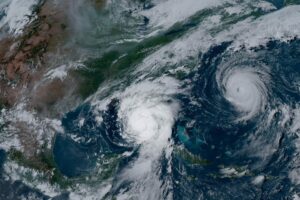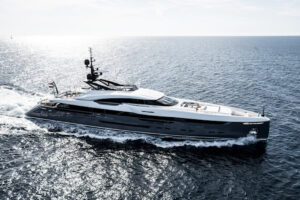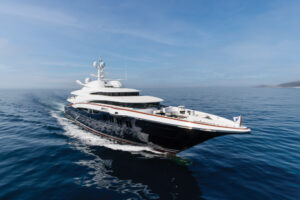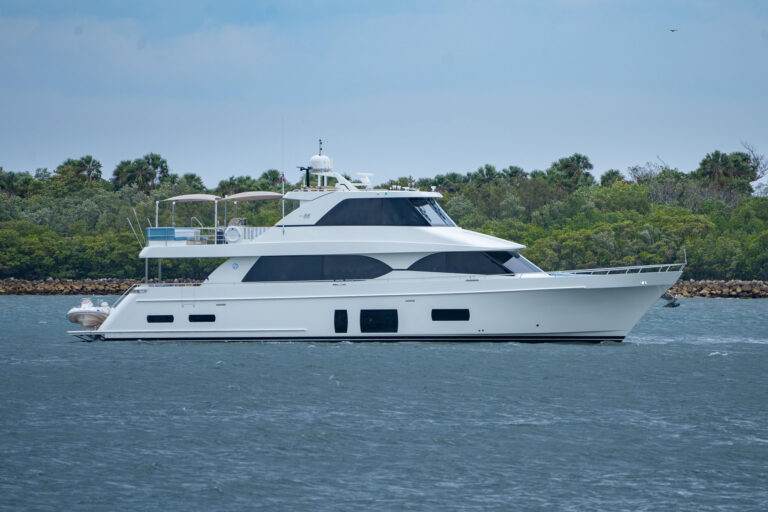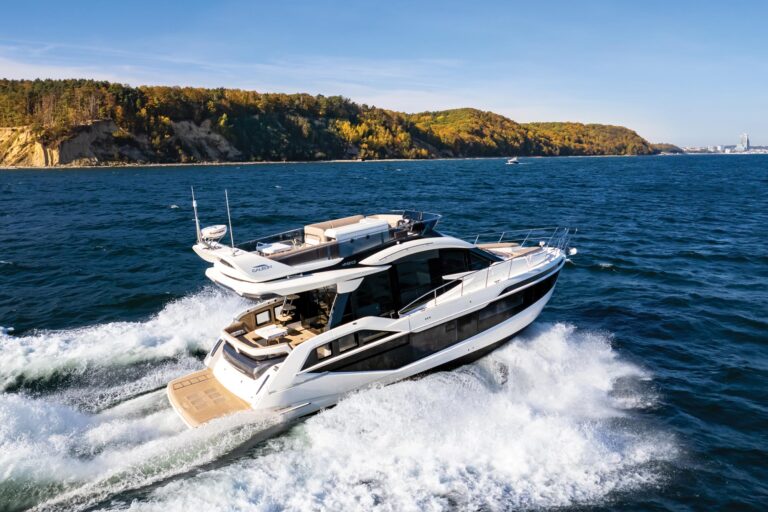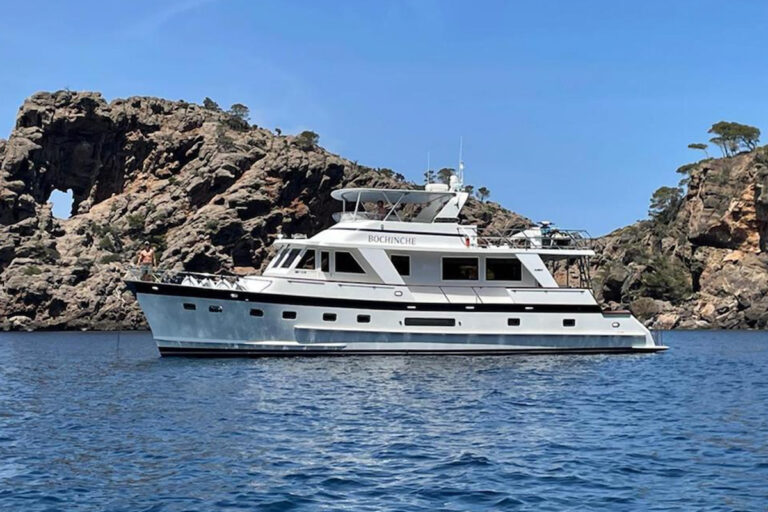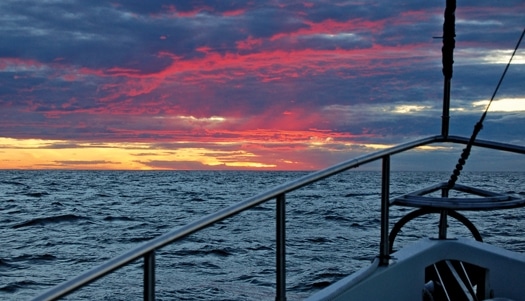
ytgjan26cynord525.jpg
Our 46-foot Nordhavn trawler, Egret, spent her first 2½ years on the east coast of the U.S., traveling as far north as Nova Scotia and as far south as the Dominican Republic. The next 2½ years were spent in the Mediterranean, crossing the Atlantic as a participant in the Nordhavn Atlantic Rally. Departing the Med, she traveled south to the Canary Islands, re-crossed the Atlantic to Brazil, then went south to Argentina and Chile where she spent the next year. The following year she left mainland Chile and visited Robinson Crusoe Island (450 nm off the coast of Chile), Easter Island, Pitcairn Island, the Gambier Island group, then Tahiti and French Polynesia, Cook Islands, American Samoa, and the Kingdom of Tonga. She crossed the Pacific and is currently in Tasmania. Our little white fiberglass ship has now traveled more than 40,000 nautical miles.
So, what does this have to do with you? Everything! We didn’t start off crossing oceans. We had done a lot of small-boat boating but essentially had no previous cruising experience. After taking delivery of Egret, we were liveaboards for six months before we retired and sailed into the sunset. During this stage, we spent as much time as possible anchored here and there for the weekends. We bashed docks, got stuck in the mud, and made navigational errors. That’s right-we made mistakes, lots of them. However, we learned from them. Our egos survived as well. After retirement, we immediately left our hometown of Ft. Lauderdale and made our first nonstop, offshore passage along Florida’s east coast to St. Mary’s Inlet at the Florida- Georgia border. We were so nervous but determined to learn as much as we could about passagemaking. And we did. All in baby steps-baby steps are the key.
So, let’s say you buy into this picture and purchase a boat of some type. As time and miles go by you will naturally push your comfort level here and there. However, there are usually two of you boating. Your comfort levels may not be the same. You have several choices: You can yell at each other about this and that, hoping to make your point; or, if either of you have anxieties, talk about them openly, then set about working on the issues as a team. When you are at sea, all you have are each other. Mary and I have always been close, but since we have been cruising we have become even closer. We don’t just want company-we need each other. Most every long-distance cruising couple, power or sail, is the same.
Let me tell you a sad story about some cruisers we know, then look at the big picture. The admiral was so nervous about docking that she would take a prescriptive happy-pill beforehand. So, now Alice in Wonderland was trying to help dock the boat. Sure, her anxiety was gone but the vessel’s safety was compromised. Next came the dinghy trials. Their dinghy was a super heavy one for a relatively small boat. When launching the dink from the boat deck in a chop, it became a swinging lethal weapon- a big problem. (There were a couple of small, easily solved issues as well, to be accurate.) Bottom line-the boat went on the market and a dream was shattered. Now, let’s look at the big picture. The captain should have taken the time to practice, over and over, until he could comfortably dock the boat, and the admiral was comfortable as well. On the heavy dinghy issue, simple solution: Get rid of it and buy a simpler, lighter dinghy. Who knows, if they had addressed these easily resolvable problems they might still be happily boating today.
Here is a short list of issues where you may have concerns.
Mechanics It isn’t the big things that fail. Egret’s happy little Lugger main engine has over 7,000 engine hours. It doesn’t even occur to us that the Lugger would fail. It is the little nuisance items that pop up. These items aren’t rocket science. A fresh water pump, for example, is two wires and two hoses. Replace the nonworking pump with a new one from spares and work on the defective one at your leisure. I promise you will feel great when you get the old pump working once again.
Handling Your Boat in Large Seas Like most any endeavor in life, the more you learn and practice, the easier it becomes. I would recommend pushing your comfort level in seas near a safe harbor. Purposely go out in largish seas and higher winds. Please don’t start off in a gale. Start a bit easier. Both of you should run your boat in every direction to the waves, at different speeds. Learn your boat. Discuss the differences between yourselves. However long it takes for both of you to become comfortable is unimportant. What does matter is progress together, as a team. There are times when a slight change in direction or speed makes a large difference in comfort or speed versus fuel burn. This past year in the Pacific, we increased our engine rpms by just 50, but increased our speed by one full knot. That may not sound like much, but when you are pounding into short, tight, head seas and making only 5.3 knots, a full knot increase is huge. As far as ultimate safety, in time you realize that as long as you don’t let water into the boat you will be okay-perhaps uncomfortable, but safe. With sea miles comes comfort (physical and mental) and safety.
Navigation Not to worry-with today’s electronics, navigation is simple. The little green boat slowly marching along an electronic chart is you. I will say, however, that electronic navigation away from highly traveled areas must be closely watched. Again, after your baby steps, this is a lesson you will have learned. If you will be traveling in foggy areas, radar is a must. Basic radar operation is not difficult. A couple hours spent with a knowledgeable boating buddy will get you started. In time you will learn to trust your radar, and in fog, it will become your new best friend. Another aid to navigation is simply your eyes. Look around. A pair of quality 7 x 50 binoculars are a must. We keep two pairs of Nikon binoculars in the pilothouse, each adjusted to our preference. A good depthfinder is also crucial. (We have a backup digital depthfinder we have never used.) A machine that can read bottom contours is best. With a little practice you will be able to tell whether you are dropping your anchor in rock (not good) or a smooth, muddy, or sand bottom. The lesson here is that navigation is not difficult, but never rely on a single source of information. Use every source at your disposal.
Seasickness We both used to get seasick. Mary started off using marezine, an offthe- shelf drug, and now is weaned of any medication. Today, after a layoff from ocean travel, she has to get acclimated by laying down for a couple hours once underway. My seasickness left years ago. If, in the end, one of you still gets seasick on occasion, let me pass on a little secret. Two of the most recognized sailboat magazine authors, both veterans of multiple circumnavigations, still get seasick on occasion. However, both want to be out cruising, so the occasional discomfort is well worth the price.
Weather Coastal cruising during your baby-step stage will let you become familiar with weather. There are many sources of nearshore weather: VHF, satellite radio/weather, and web-based weather such as www.buoyweather.com, www.windguru.com, and others. Offshore, we download GRIB files using Ocens software (www.ocens.com) and an Iridium phone. In addition, on our journey from Gibraltar to New Zealand, we used the services of professional weather forecaster OMNI Bob, aka Bob Jones, at www.OceanMarineNav.com. When well offshore, we feel professional weather forecasting is another form of boat insurance-and comfort insurance.
Tides In much of the U.S., tides aren’t an issue. In the Pacific Northwest and higher latitudes on the east coast of the U.S. and Canada, tides are a big issue. Tide tables are available in book form as well as electronically. Once you figure out which direction is flood and which is ebb, the rest is simple. And you will quickly learn not to anchor where the chart says there isn’t enough water at low tide, even if it looks deep at the time!
Docking Most of us feel the world is watching when we dock. In actuality, another person’s docking is a minor distraction. Nothing more. And what if, heaven forbid, you get a scratch? Well, so what? It’s just a boat! Gelcoat scratches are easy to fix. Egret has lots of battle scars we will fix someday. It’s okay. Look where she has taken us, what we have seen, what we have done. Worrying about scratches isn’t worth our time.
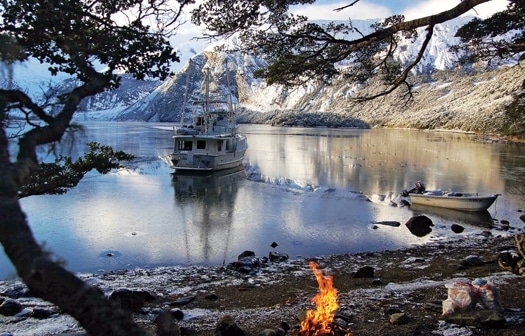
| | |
So, what are the benefits of cruising? You will breathe clean air. You will eat better. You will feel better. If you take your children or grandchildren cruising, the gift of what we simply call “water” surpasses any gift money can buy. Cruising will break the ever tightening, suffocating routine where most folks seem to get trapped as they age. You will meet more new friends in anchorages than you ever did at work or in your neighborhood- not because you aren’t friendly, but because you’ll have more time. Time, as you know, is something you cannot buy. And every day you will learn to enjoy and live your life. A beautiful sunrise or sunset, dolphins in the bow wake, and sundowners with yachtie neighbors will replace the short-lived pleasure burst another “thing” or more “stuff” gives. And so on-you get the picture.
There are thousands of us slowly circling the world today, by power and under sail, and many more thousands enjoying coastal cruising. What we do is not a competition. I promise you, few, if any, had the skills they now have when they started. You and your other would be no different.
The gannets have been circling all day and diving on baits. They hover around 80 feet up, fold their wings, and enter the water like a dart, with a slight swoosh sound. Soon a large air bubble pops up. Shortly after that the gannet pops to the surface like a cork, swallows its snack, and shakes itself off. Then, paddling with its feet and flapping its wings, it is soon airborne again.
Interested? The ball is in your court.
Read more about the adventures of Scott and Mary Flanders aboard Egret-and check out more of their beautiful photography-at www.nordhavn.com_._

